C-130H Hercules
American Heavy Transport Plane
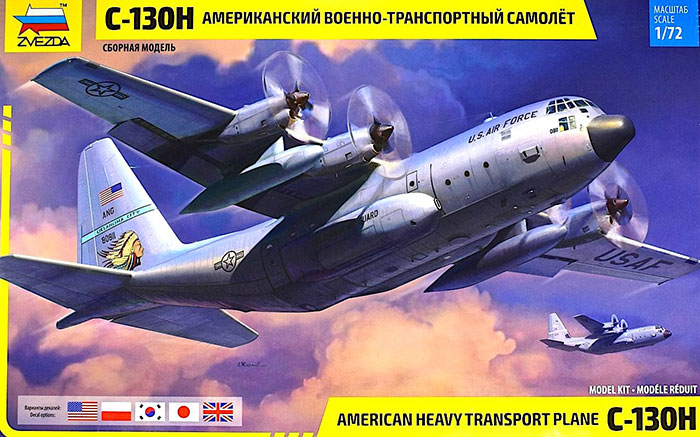
Zvezda, 1/72 scale
S
u m m a r y : |
Description and Item No.: |
Zvezda Kit No. 48170 - C-130H Hercules American Heavy Transport Plane |
Contents and Media: |
194 parts in grey styrene, 24 in clear, and one decal sheet with markings for 5 airframes. |
Price: |
£41.66 Plus Shipping from Hannants |
Scale: |
1/72 |
Review Type: |
First Look |
Advantages: |
This new mold kit is a step up in accuracy and detail over the older Italeri offering. Simple engineering and practically no flash suggest an enjoyable build. |
Disadvantages: |
Although the decals are nice overall, the markings for the Japanese option show bleed through and are not useable. |
Recommendation: |
This will be a very impressive kit assembled. Highly Recommended. |
Reviewed by John Miller

The Lockheed C-130 Hercules is an American four-engine turboprop military transport aircraft designed and built originally by Lockheed (now Lockheed-Martin). Capable of using unprepared runways for takeoffs and landings, the C-130 was originally designed as a troop, medevac, and cargo transport aircraft. The versatile airframe has found uses in a variety of other roles, including as a gunship (AC-130), for airborne assault, search and rescue, scientific research support, weather reconnaissance, aerial refueling, maritime patrol, and aerial firefighting. It is now the main tactical airlifter for many military forces worldwide. More than 40 variants of the Hercules, including civilian versions marketed as the Lockheed L-100, operate in more than 60 nations.

The C-130 entered service with the U.S. in 1956, followed by Australia and many other nations. During its years of service, the Hercules family participated in numerous military, civilian, and humanitarian aid operations. In 2007, the C-130 became the fifth aircraft to mark 50 years of continuous service with its original primary customer, which for the C-130 is the United States Air Force. The C-130 Hercules is the longest continuously produced military aircraft at over 60 years, with the updated Lockheed Martin C-130J Super Hercules currently being produced.
Design and Development
The Hercules resembled a larger four-engine version of the C-123 Provider with a similar wing and cargo ramp layout that evolved from the Chase XCG-20 Avitruc, which in turn, was first designed and flown as a cargo glider in 1947. The Boeing C-97 Stratofreighter had rear ramps, which made it possible to drive vehicles onto the airplane (also possible with forward ramp on a C-124). The ramp on the Hercules was also used to airdrop cargo, which included a Low-altitude parachute-extraction system for Sheridan tanks and even dropping large improvised "daisy cutter" bombs. The new Lockheed cargo plane had a range of 1,100 nmi (1,270 mi; 2,040 km) and it could operate from short and unprepared strips.
The first flight of the YC-130 prototype was made on 23 August 1954 from the Lockheed plant in Burbank, California. The aircraft, serial number 53-3397, was the second prototype, but the first of the two to fly. The YC-130 was piloted by Stanley Beltz and Roy Wimmer on its 61-minute flight to Edwards Air Force Base; Jack Real and Dick Stanton served as flight engineers. Kelly Johnson flew chase in a Lockheed P2V Neptune.
After the two prototypes were completed, production began in Marietta, Georgia, where over 2,300 C-130s have been built through 2009. The initial production model, the C-130A, was powered by Allison T56-A-9 turboprops with three-blade propellers and originally equipped with the blunt nose of the prototypes. Deliveries began in December 1956, continuing until the introduction of the C-130B model in 1959. Some A-models were equipped with skis and re-designated C-130D. As the C-130A became operational with Tactical Air Command (TAC), the C-130's lack of range became apparent and additional fuel capacity was added with wing pylon-mounted tanks outboard of the engines; this added 6,000 lb (2,720 kg) of fuel capacity for a total capacity of 40,000 lb (18,140 kg).
The C-130H (the subject of the Zvezda kit) has updated Allison T56-A-15 turboprops, a redesigned outer wing, updated avionics, and other minor improvements. Later H models had a new, fatigue-life-improved, center wing that was retrofitted to many earlier H-models. For structural reasons, some models are required to land with reduced amounts of fuel when carrying heavy cargo, reducing usable range. The H model remains in widespread use with the United States Air Force (USAF) and many foreign air forces.
Initial deliveries of the H model began in 1964 (to the RNZAF), remaining in production until 1996. An improved C-130H was introduced in 1974, with Australia purchasing 12 of type in 1978 to replace the original 12 C-130A models, which had first entered Royal Australian Air Force (RAAF) service in 1958. The U.S. Coast Guard employs the HC-130H for long-range search and rescue, drug interdiction, illegal migrant patrols, homeland security, and logistics.
United States Coast Guard HC-130H
C-130H models produced from 1992 to 1996 were designated as C-130H3 by the USAF. The "3" denoting the third variation in design for the H series. Improvements included ring laser gyros for the INUs, GPS receivers, a partial glass cockpit (ADI and HSI instruments), a more capable APN-241 color radar, night vision device compatible instrument lighting, and an integrated radar and missile warning system. The electrical system upgrade included Generator Control Units (GCU) and Bus Switching units (BSU) to provide stable power to the more sensitive upgraded components.
Royal Air Force C-130K (C.3)
The equivalent model for export to the UK is the C-130K, known by the Royal Air Force (RAF) as the Hercules C.1. The C-130H-30 (Hercules C.3 in RAF service) is a stretched version of the original Hercules, achieved by inserting a 100 in (2.54 m) plug aft of the cockpit and an 80 in (2.03 m) plug at the rear of the fuselage. A single C-130K was purchased by the Met Office for use by its Meteorological Research Flight, where it was classified as the Hercules W.2. This aircraft was heavily modified (with its most prominent feature being the long red and white striped atmospheric probe on the nose and the move of the weather radar into a pod above the forward fuselage). This aircraft, named Snoopy, was withdrawn in 2001 and was then modified by Marshall of Cambridge Aerospace as flight-testbed for the A400M turbine engine, the TP400. The C-130K is used by the RAF Falcons for parachute drops. Three C-130Ks (Hercules C Mk.1P) were upgraded and sold to the Austrian Air Force in 2002.
(Edited from Wikipedia)
The kit comes in a large box, inside of which there’s as awful lot of styrene much of in the form of large airframe components. All the sprues are bagged while the rather large decal sheets are protected within the similarly large instructions. “Large” is the word; this will be a big model when assembled. In the accompanying photograph note the size of the fuselage relative to a P-51 (Tamiya) and Vultee Vengeance (Special Hobby) of the same scale.

Close inspection reveals very little flash on most components and surprisingly small sprue gates. The surface details and inscribing are crisp, and restrained over the entirety of the model. This kit is going to look beautiful under carefully applied paint and a wash to enhance the surface details. Parts layout and engineering are conventional. That said assembly begins with the cockpit, wherein there’s a lot of detail right out of the box.
In addition to the two-piece control yokes and rudder pedals, the nicely molded flight crew seats have separate arm rests: nice. Crisply printed decals are provided for both the main instrument panel and flight engineer station. Detailed painting instructions for the cockpit and flight crew are provided that are keyed to the Tamiya range.
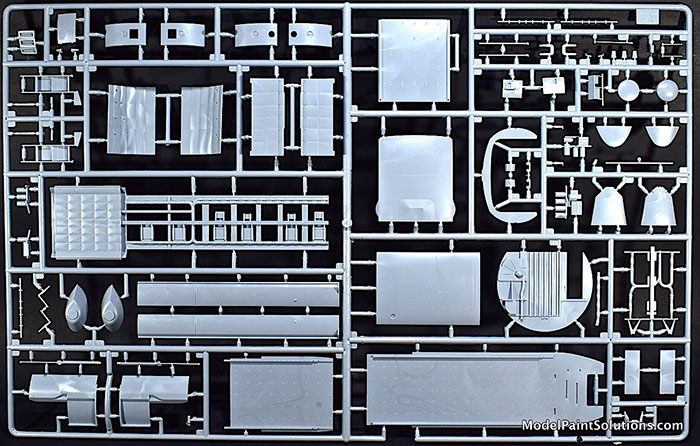
Once the flight deck is completed the builder is directed to begin assembly the small galley area behind the flight deck as well as the main cargo area, which is nicely detailed as well. Builders will have to decide which of the 5 schemes they’re building as there are fuselage inserts, doors (cargo vs paratroop), and portholes that are scheme-specific.
Moving to the outside of the fuselage halves, the builder is directed to assemble and affix the sponsons; short or long, depending on the variant being built. Similarly, variant-specific flight deck windows and fuselage panels, with small or large cooling vents, are glued in place at this stage.
One is struck with the wealth of detail provided in the cargo area right out of the box. Fortunately the loading ramp can be built in the extended configuration, allowing a lot of that to be detail to be seen by the more inquisitive.
Once the fuselage halves are joined, the wings and wing center section are next in sequence.
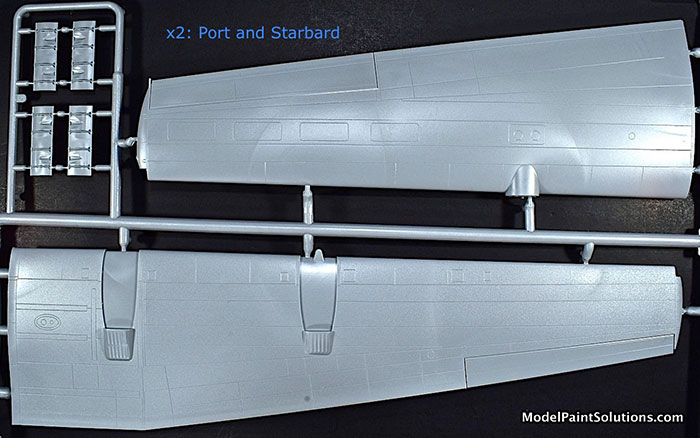
I’m always concerned about wing-droop with a model of this size and layout. Two engines and a wing tank per side is a fair amount of weight on an all-styrene structure, especially with time in the display cabinet. That said the design of the wing center section incorporates four separate, internal, airfoil-shaped supports arranged so as to over lap on each side of the wing centerline. This design will confer a lot of rigidity to the assembled center section: very nice. The design does lend itself to the insertion of additional (read metal) spars should the builder wish to add these.
With the wing built, we’re directed to begin assembling the multi-piece engine nacelles, which are nicely detailed and exhibit the same restrained surface inscribing as found on the larger components. The wing tanks, which have variant-specific parts are also assembled at this stage.
Next, the assembled fuselage is offered up to the completed wing followed by the horizontal stabilizer/elevator assemblies (from halves). One of the three different nose cones, which are variant specific is added as well thereby completing the airframe.
The nose gear, main gear, and wheels (from halves) are all nicely detailed and cleanly molded as are the door actuators and gear doors.
The nicely molded propellor blades with two-piece hubs are next in sequence followed by the crew doors, cargo ramp, and external fueling probe (for the RAF version only).
The windscreen and other clear parts are crisply molded and crystal clear.
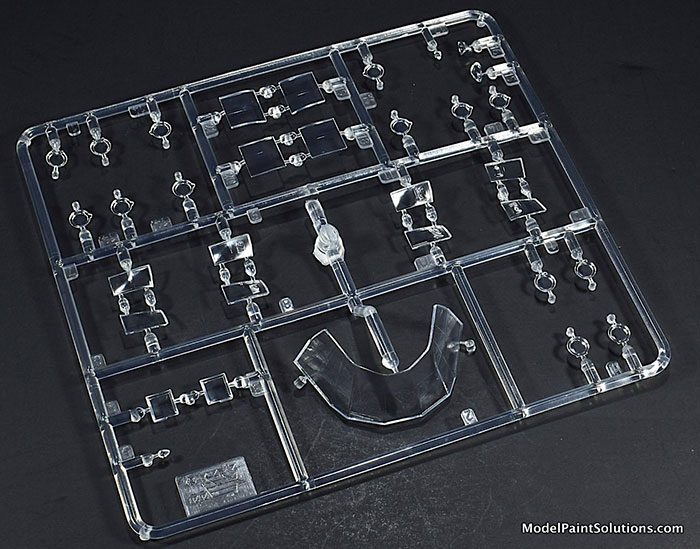
Test fitting looks promising too.
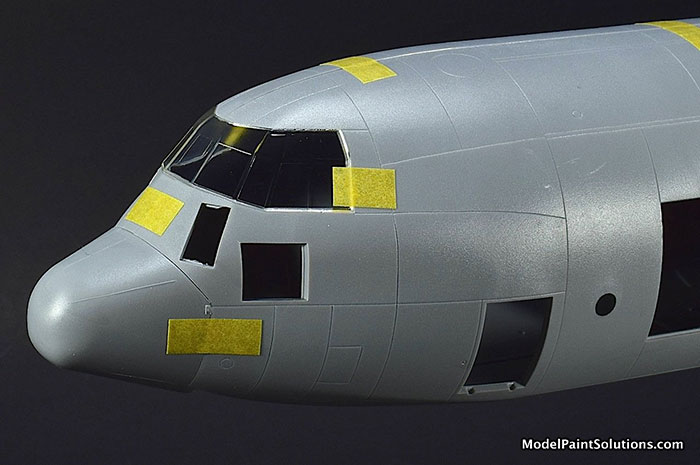
Markings:
The decals, by Zvezda, are well printed with good registration and color density with the exception of the Japanese Hinomaru’s, which show bleed through of the red through the white surround.
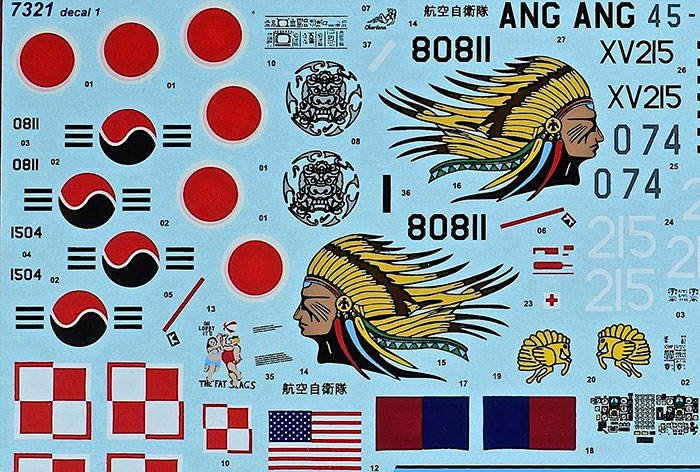
Airframe stencil data and markings for five airframes are provided as follows:
-
C-130H (78-0811), 758th Airlift Squadron, USAF, Pittsburg Airbase, 2007.
-
C-130E, 14th Airlift Squadron, Polish Air Force, Powidz, Airbase, 2007.
-
C-130H (95178), 15th Composite Transport Squadron, Republic of Korea Air Force, Seongnam Airbase, 2012.
-
C-130H (83-0002), 401st Tactical Airlift Squadron, Japanese Air Self Defense Force, Komaki Airbase, 2020.
-
C-130K (66-8565), Lyneham Transport Wing, Royal Air Force, Lyneham Airbase, 1991. Note: This aircraft took part in Operation Desert storm.

Stencil data is supplied on a larger separate sheet.
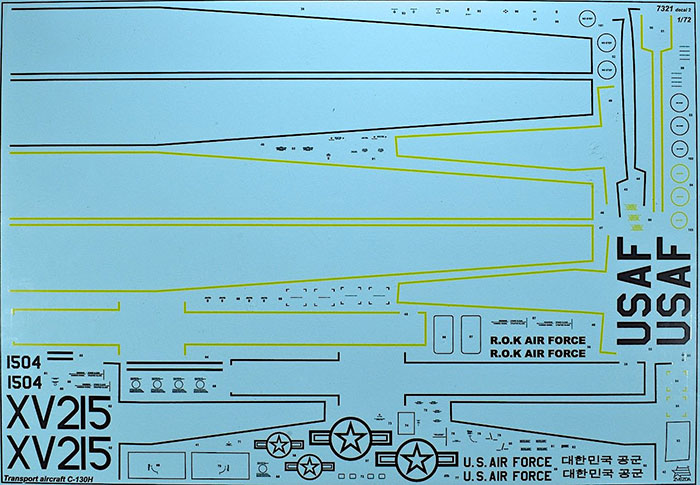
This is a nice kit. The moldings are clean with little flash and the engineering is simple and straightforward. The level of detail is sufficient for this scale over all and a cut above in the cargo area. I see no apparent issues laying in wait. Other than the markings for the Japanese scheme, the decals are well done and cover some very colorful options. This will be a very impressive kit assembled. Highly Recommended !
For more on this review visit Modelpaintsolutions.com.
Review kit provided by my retirement fund, again.
Review Text and Images Copyright © 2020 by John Miller
Page Created 10 December, 2020
Last updated
10 December, 2020
Back to HyperScale Main Page
Back to Reviews Page

|
Home
| What's New |
Features |
Gallery |
Reviews |
Reference |
Forum |
Search